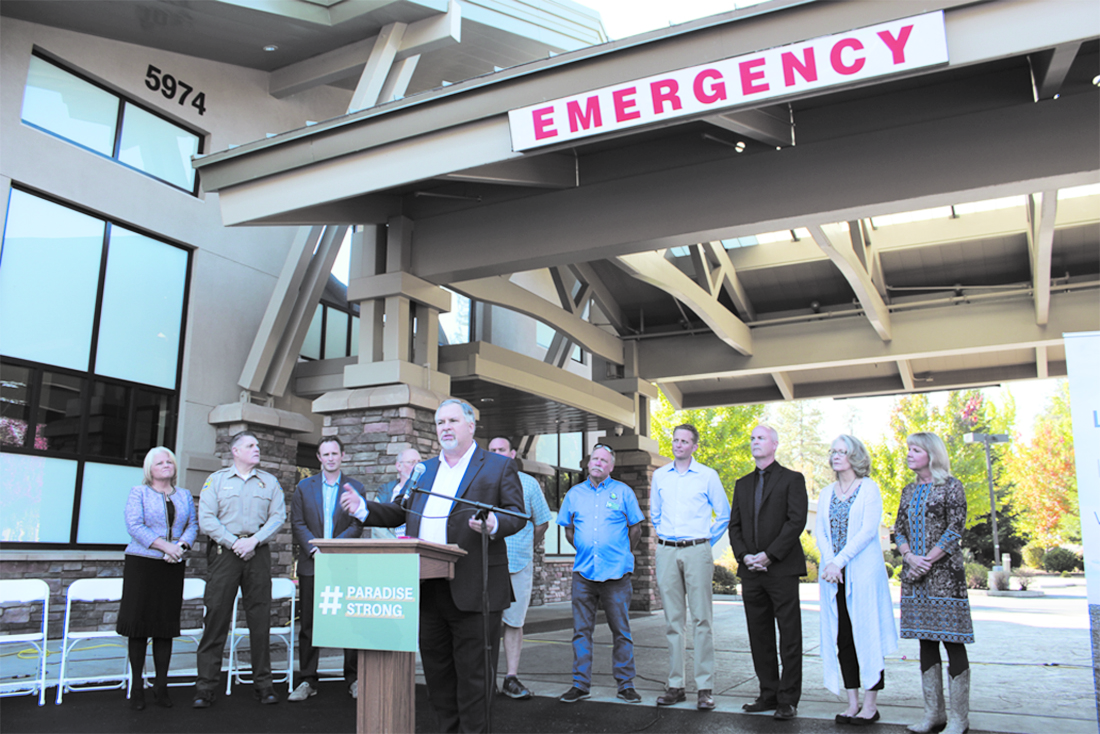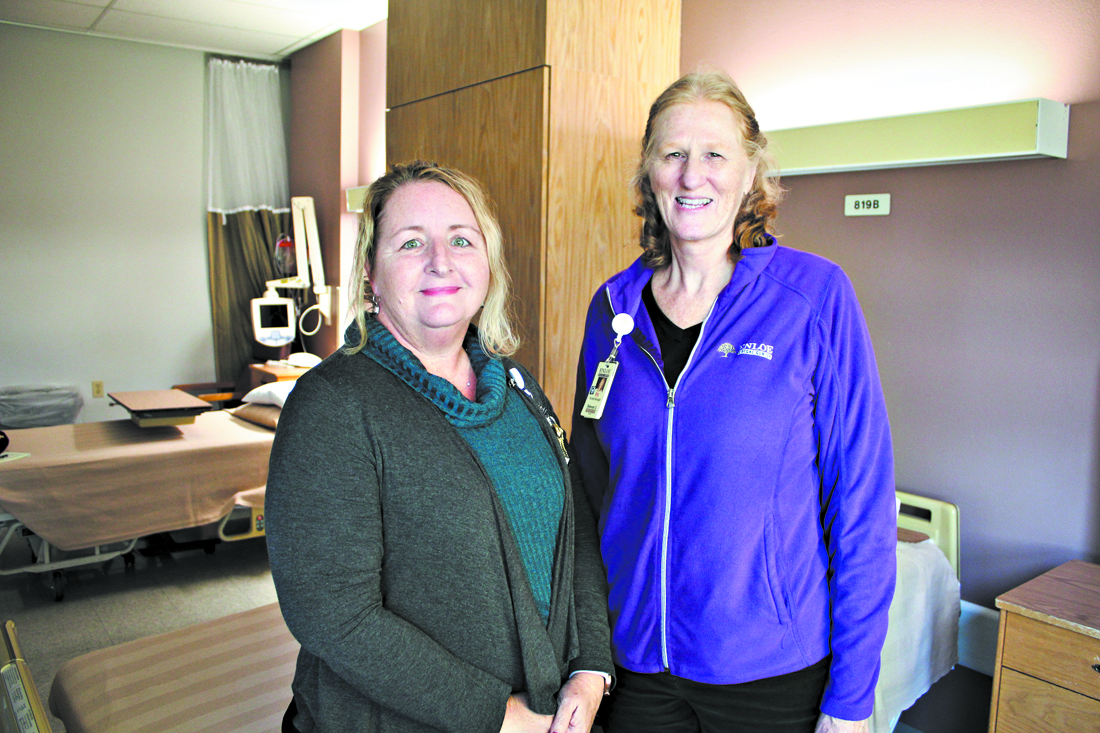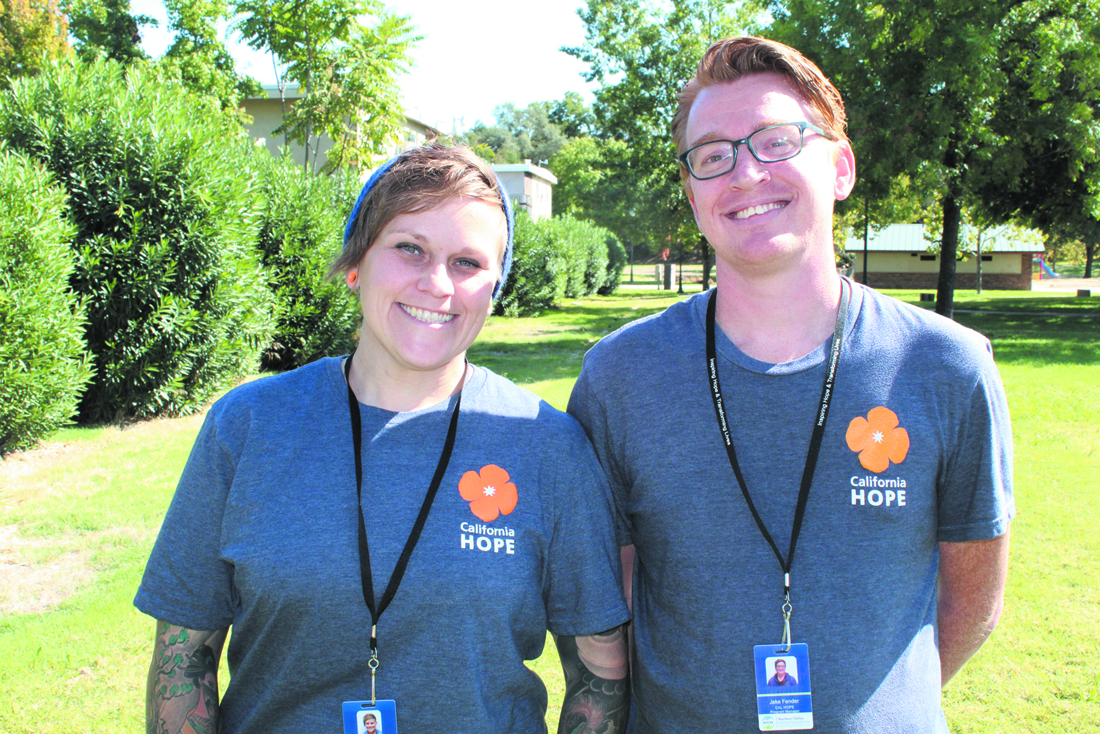
Photo by Ashiah Scharaga
Rick Rawson, Adventist Health CEO, confirms that the Feather River Hospital emergency room will reopen.
This year, the health care desert grew in the wake of the Camp Fire. Paradise already was classified as a medically underserved area by the federal government, and the North State as a whole was among the rural California regions suffering a chronic shortage of physicians. So, the exodus of Ridge providers post-fire compounded an existing problem. But it was also a year in which the community made considerable progress, and banded together to provide care to those in need.
Here are the top health care-related issues and projects this year.
Comeback kid
The future of Adventist Health Feather River Hospital was murky for much of 2019. The facility, which lost portions of its Pentz Road campus during the fire, issued final paychecks to 798 employees in February and suspended its license in March.
But that’s not to say Feather River wasn’t busy: In April, it opened a new Cancer Care Center in Chico. The following month, the hospital partnered with Enloe Medical Center to focus on a post-Camp Fire health care plan, including access, prevention and wellness initiatives throughout the county. This year, it also reopened its Paradise clinic offering primary and specialty services, expanded similar services in Chico and Corning, and re-established home health services in Butte County.
Legislators were busy, too. Gov. Gavin Newsom signed Senate Bill 156 in October, paving the way for Adventist Health to operate a standalone emergency room through 2027. Adventist Health CEO Rick Rawson couldn’t provide a timeline, citing the facility’s needed repairs, funding and operational plans. But the reopening will be critical not only for Paradise residents, but also for those living in Magalia and outlying Ridge communities.
Struggling to keep up

Photo by Ashiah Scharaga
Michelle Evans, Enloe’s director of case management (left), and Transitional Skilled Unit Nurse Manager Debbie Strukan visit a room reserved for patients needing skilled-nursing care at the Enloe Rehabilitation Center.
In the aftermath of the fire, Enloe Medical Center and Oroville Hospital both took on more patients. But the Chico hospital struggled to meet the increased demand for services across the board. Emergency room visits, for example, jumped by about 100 patients daily.
Meanwhile, the hospital found itself focused on addressing another emergent need: skilled nursing care. The Camp Fire wiped out approximately 300 nursing home beds. Immediately after the fire, Enloe secured licensing that allowed it to accommodate some additional patients awaiting placement in a nursing home. Then, in August, Enloe opened a new Transitional Skilled Unit made up of 20 beds within its rehabilitation center on East Avenue to serve those patients. CEO Mike Wiltermood informed the CN&R last week that the once-temporary unit will be open indefinitely.
Even with the new accommodations, however, the ongoing shortage of nursing home spaces means patients are staying in the hospital longer. Wiltermood estimated Enloe was spending about $20,000 to $40,000 more per day on about 20 to 40 such patients. To defray this additional cost, the hospital pursued a “sole community hospital” designation with the Centers for Medicare & Medicaid Services (CMS), which could mean an additional $20 million to $40 million per year for Enloe. But the application was denied, and Enloe will plead its case to an appeals board in 2020.
Unhealthy county
The Department of Public Health’s latest Community Health Assessment (CHA) was released in November, revealing that Butte County residents aren’t faring so well when it comes to their well-being. While the drug- and opioid-induced death rates have dropped in Butte County since the last assessment in 2015, they’re still much higher than the state or national averages. And Butte County teens are starting drugs and alcohol early, too. The number of those who reported ever trying alcohol or illicit drugs (including misusing prescription medications) “was greater for all grade levels for nearly every category than in California overall,” the report reads. Butte County also has a higher-than-average rate of chronic illnesses, such as cancer, Alzheimer’s disease and chronic liver disease.
Moving forward, the county will analyze the CHA to create a health improvement plan to come up with solutions, which should be produced around January.
Preventable crisis
Measles reached Butte County this past March. It was one of a string of outbreaks among predominantly unvaccinated children after overseas travelers brought the virus back to the States. This year marked the worst for measles since 1992 (it was declared eradicated in 2000): Nationwide, 1,276 cases were confirmed across 31 states, according to the U.S. Centers for Disease Control and Prevention. In Butte County, the Public Health Department confirmed a total of 13 local measles cases between March and May.

Photo by Ashiah Scharaga
Jess Mercer and Jake Fender are part of California HOPE, a FEMA-funded program facilitated by Butte County Behavioral Health that has been providing mental health crisis care to Camp Fire survivors since the disaster.
The disease is virulent but preventable. People got vaccinated for three decades with little controversy until a study suggested MMR—a combination vaccine for measles, mumps and rubella—caused autism. Though it has long since been debunked, that 1998 report sparked a 21st century anti-vaxx movement, which experts say has contributed to measles outbreaks among schoolchildren.
Feeling it out
Trauma and mental health care was spotlighted in Butte County this year, particularly in light of the Camp Fire. Local experts confirmed that many survivors are still struggling emotionally—a difficulty compounded for those who aren’t able to meet their basic needs, such as water, food, clothing and shelter.
Crisis outreach workers with California HOPE—a Federal Emergency Management Agency-funded program facilitated by Butte County Behavioral Health—have been working to address these issues since the wildfire, and as of November, had provided nearly 6,000 individual counseling visits and over 46,000 group visits, primarily with children.
In addition, two Butte Strong grants—$232,000 awarded in January and $1.86 million awarded in June—supported trauma response, healing and recovery initiatives for all Butte County schools, including charter and private schools.
The Butte Strong Fund also provided a number of other, much smaller grants for several art-therapy projects.
Free mental health care services also were provided via a new nonprofit called Medspire Health. The all-volunteer organization of medical providers focuses on offering free non-emergency health care to Camp Fire survivors, hosting several clinic days on the Ridge and making home visits.
In full swing
Butte County has been a hot spot when it comes to the rate of painkillers prescribed per person, and has an above-average opioid-induced death rate. In its efforts to tackle the epidemic, Ampla Health launched its first clinic offering opioid addiction treatment early this year in Oroville—the clinic specializes in prescribing buprenorphine, an opioid medication used to treat addiction. The health care provider experienced such a demand that it sought and was awarded a $200,000 grant from the California Department of Health Care Services’ MAT Access Points program to expand its services. This year, it added more buprenorphine prescribers at its Olivehurst and Chico clinics and expanded those services in Oroville and Yuba City. Plus, four full-time opioid-use disorder counselors came on board for all four locations.
